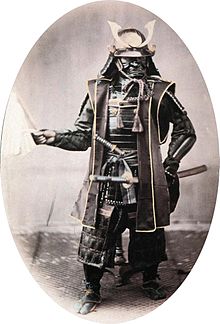User:Chvietz/History project
Samurai
[edit]
The word samurai means to serve.[1] The Samurai were a powerful military caste of Japan that rose to power in the 12th century. Many of them served in the emperor's army. [2] They used many weapons which included the katana, yumi, hanbo, and kusari-fundo. The Samurai lived their lives by a set of rules that are known as Bushido, which means the "way of the warrior".[3] They were usually well educated and knew kanji, the system of writing that was used at that time. Sons were trained in the martial arts by their father, and if they came from a wealthy family they were sent to special schools to be tutored in the arts, literature, and military skills.
Dress
[edit]Men wore kimonos, which usually consisted of an outer and inner layer of cloth. Women also wore kimonos, but they were usually made of silk. In battle, armor that typically included a helmet, shoulder pads, various types of armored jackets, and a throat or neck guard was worn. They generally carried two curved swords, one long and one short, and sometimes a bow, however there were numerous different types of weapons that they used on the battlefield.
Weapons
[edit]The samurai used many different types of weapons. They were masters of the bow, swords, and they knew how to fight with only their hands incase their weapons were lost on the battlefield. They generally wore two swords on their waist. the most widely known of these two swords was the katana. The other sword was either a wakizashi, or a shoto. Besides these two swords they wore, they used bows and variations of the katana.
Way of Life
[edit]The samurai lived their lives by a code of rules called bushido. This code and stressed frugality, loyalty, mastery of martial arts, and honor to the death. Under the bushido ideal, if a samurai failed to uphold his honor, which could happen if he was defeated, he could only regain his honor by performing seppuku, or suicide. This may sound radical nowadays but back then it was very common for a samurai to commit suicide, rather than be captured by their enemies, or to regain their honor.[4]
References
[edit]- ^ The Martial Arts Book, Laura Scandiffio, Annick Press: New York, 2003, pg 34.
- ^ Japan Enchantment of the World, Ann Heinrichs, Scholastic: New York, 2006, pg 40.
- ^ Samurai, Caroline Leavitt,Capstone Press:Mankato, Minnesota, 2007, pg 14.
- ^ "Prentice Hall World History Connections To Today.", Ellis Esler,Upper Saddle River, NJ: Prentice Hall, Inc. 2003. Print. Pg 321.
